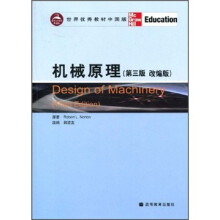Preface to the Third Edition
Preface to the First Edition.
Chapter 1 Introduction
1.0 Purpose
1.1 Kinematics and Kinetics
1.2 Mechanisms and Machines
1.3 A Brief History of Kinematics
1.4 Applications of Kinematics
1.5 The Design Process
Design, Invention, Creativity
Identification of Need
Background Research
Goal Statement
Performance Specifications.
Ideation and Invention
Analysis
Selection
Detailed Design
Protolyplng and Testing
Production
1.6 Other Approaches to Design
Axiomatic Design
1.7 Multiple Solutions
1.8 Human Factors Engineering.
1.9 The Engineering Report
1.10 Units
1.11 Whats to Come
Chapter 2 Kinematics Fundamentals
2.0 Introduction
2.1 Degrees of Freedom (DOF) or Mobility
2.2 Types of Motion
2.3 Links, Joints, and Kinematic Chains
2.4 Determining Degree of Freedom or Mobility
Degree of Freedom (Mobility) in Planar Meohanlsms
Degree of Freedom (Mobility) In Spatial Mechanisms
2.5 Mechanisms and Structures
2.6 Paradoxes
2.7 Linkage Transformation
2.8 Intermittent Motion
2.9 Inversion
2.10 The Grashof Condition
2.11 Compliant Mechanisms
2.12 Micro Electro-Mechanical Systems [MEMS]
2.13 Practical Considerations
Pin Joints versus Sliders and Half Joints
Cantilever or Straddle Mount?
Short Links
Beating Ratio
Commercial Slides
Linkages versus Cams
Chapter 3 Graphical Llnkage Synthesis
3.0 Introduction
3.1 Synthesis
3.2 Function, Path, and Motion Generation
3.3 Limiting Conditions
3.4 Dimensional Synthesis
Two-Position Synthesis
Three-Position Synthesis with Specified Moving Pilots
Three-Position Synthesis with Aiternote Moving Pilots
Three-Position Synthesis with Specified Fixed Pilots
Position Synthesis for More Than Three Positions
3.5 Quick-Return Mechanisms
Fourbar Quick-Return
Slxbor Quick-Return
3.6 Coupler Curves
Chapter 4 Position Analysis
Chapter 5 Analytical Linkage Synthesis
Chapter 6 Velocity Analysis
Chapter 7 Acceleration Analysis
Chapter 8 Cam Design
Chapter 9 Gear Trains
Chapter 10 Dynamic Force Analysis
Chapter 11 Balancing
Vocabulary of the key terms重要名词术语英汉对照表

 缺书网
缺书网 扫码进群
扫码进群





